What Is MPLS (Multiprotocol Label Switching)?

In the 1990s, MPLS was created to hasten network connections, and today it remains a cornerstone technology for Service Providers, large data centers, and enterprise networks. This article delves into MPLS‘s basics: What Is MPLS? How MPLS operates? What are its pros and cons? And MPLS’s potential for aiding your company.
Explaining MPLS (Multiprotocol Label Switching)
What Is MPLS? MPLS, or Multiprotocol Label Switching, is a data forwarding technology that speeds up and manages network traffic flow. Unlike other protocols that route data based on network addresses, MPLS routes traffic using labelled paths for forwarding over private WANs. MPLS networks offer security and flexibility, built over a private and resilient network that can be scaled to fit different site requirements. MPLS provides better transmission and higher QoS than standard IP routing, making it ideal for businesses needing a reliable, powerful connection for latency-sensitive apps like VoIP and video conferencing. Its “multiprotocol” capability means that it can transfer various data types, independent of any specific protocol used to organize them, making it a versatile solution.
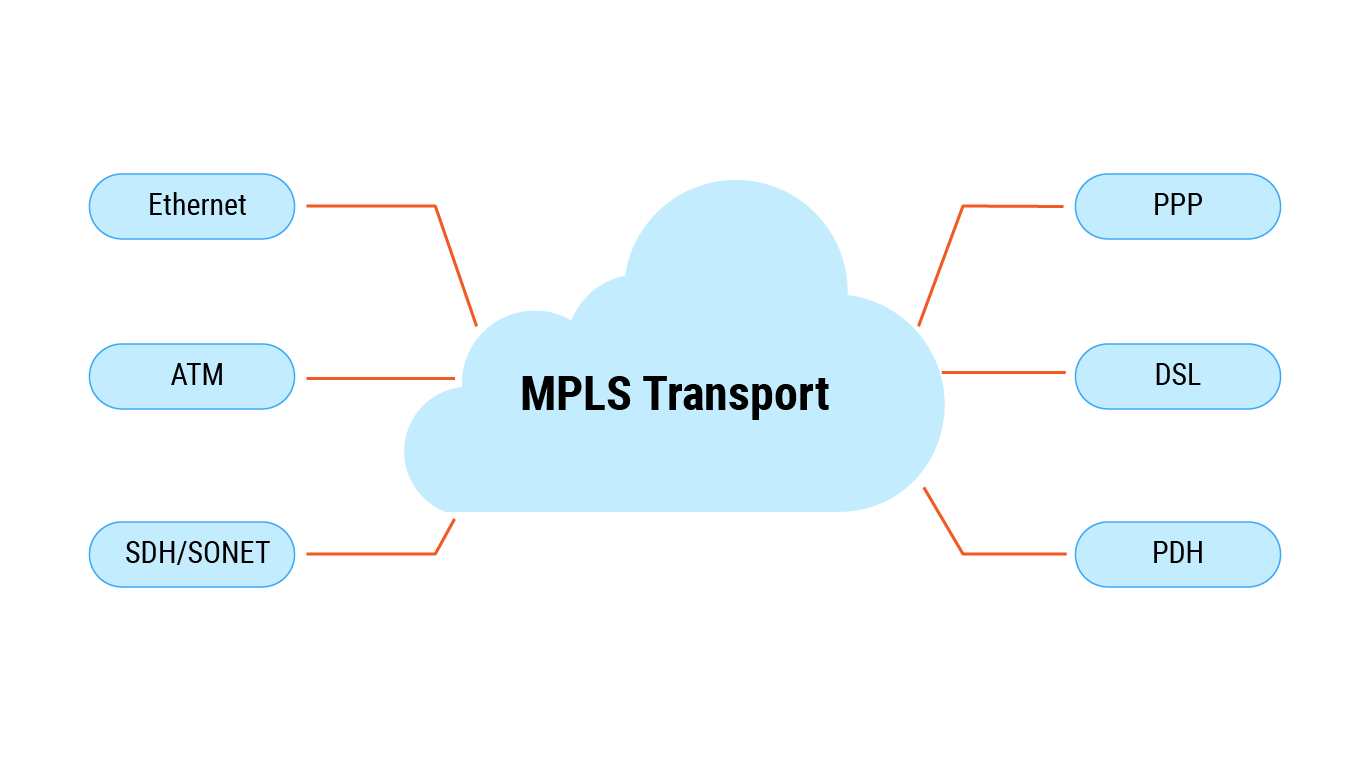
MPLS supports label switching between multiple network protocols.
The name Multiprotocol Label Switching implies that it can encapsulate packets of various network protocols, such as IP, ATM, Frame Relay, SONET, and Ethernet. To gain a better understanding of MPLS, let’s take a look at how data moves through the internet. Data sent over the internet is transmitted as an IP packet from a router to its intended destination. To reach its destination, each router performs an IP lookup (routing) to determine the next-hop. The next-hop is selected based on the router’s routing table. The router then forwards the packet to the next hop, and this process continues until the packet reaches its destination.
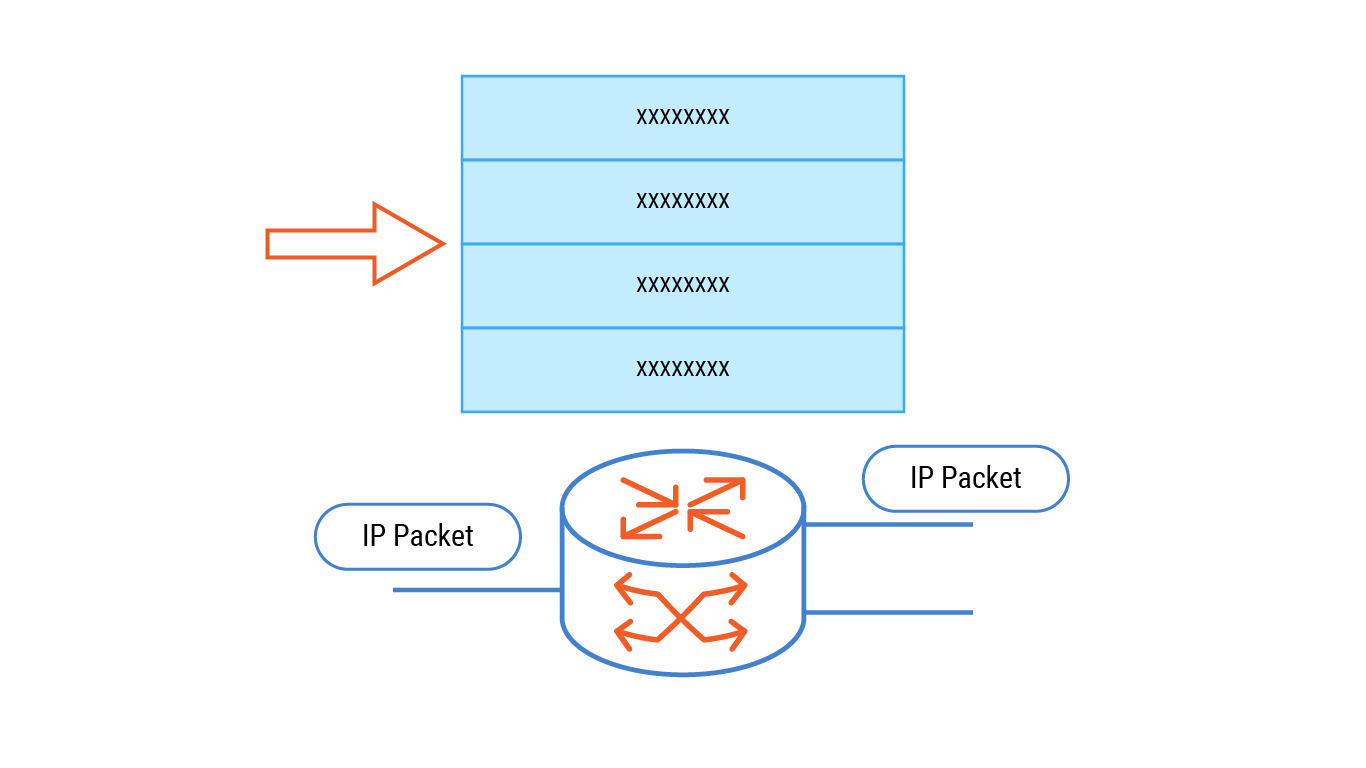
IP routing uses software for IP lookups to find the next hop, resulting in low forwarding performance.
Using IP addresses and routing tables is effective for most of the Internet, but it can take longer to forward traffic. On the other hand, Multiprotocol Label Switching utilizes a “label switching” approach to handle the data flow. Label switching is when routers within a system create a planned route that controls network traffic, resulting in faster forwarding.
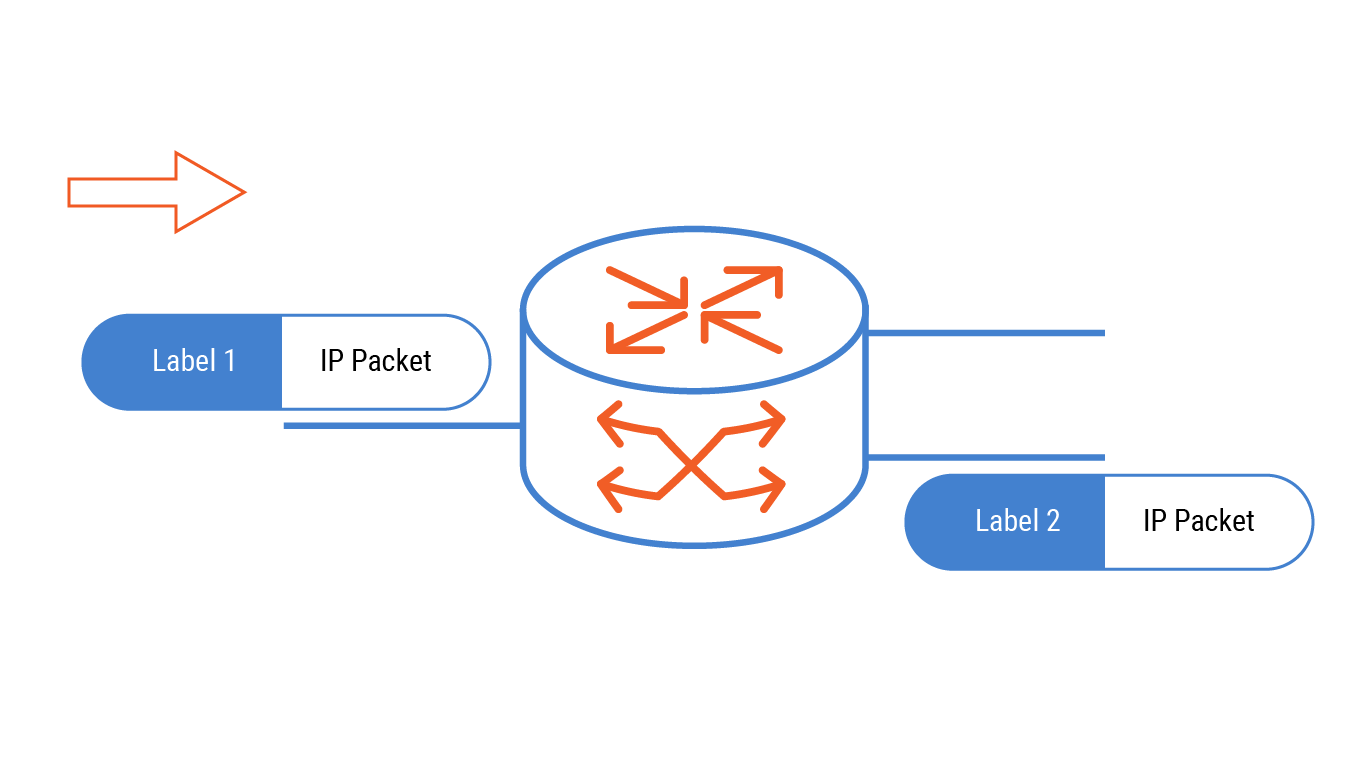
MPLS reduces the time needed to direct packet forwarding by swapping labels instead of performing IP lookups.
When the first device performs a routing lookup, it discovers the final destination router and a predetermined path from “here” to “that” router instead of a next-hop. Using this information, the router assigns a “label” to the traffic. Future routers then use the label to route the traffic rather than performing additional IP lookups. The packet will be delivered using standard IP routing, and the label will be removed at the final destination router.
Is MPLS Layer 2 or Layer 3 of the OSI model?
MPLS is referred to as a 2.5-layer protocol because of its location between Layer 2 (Data Link) and Layer 3 (Network) in the OSI model.
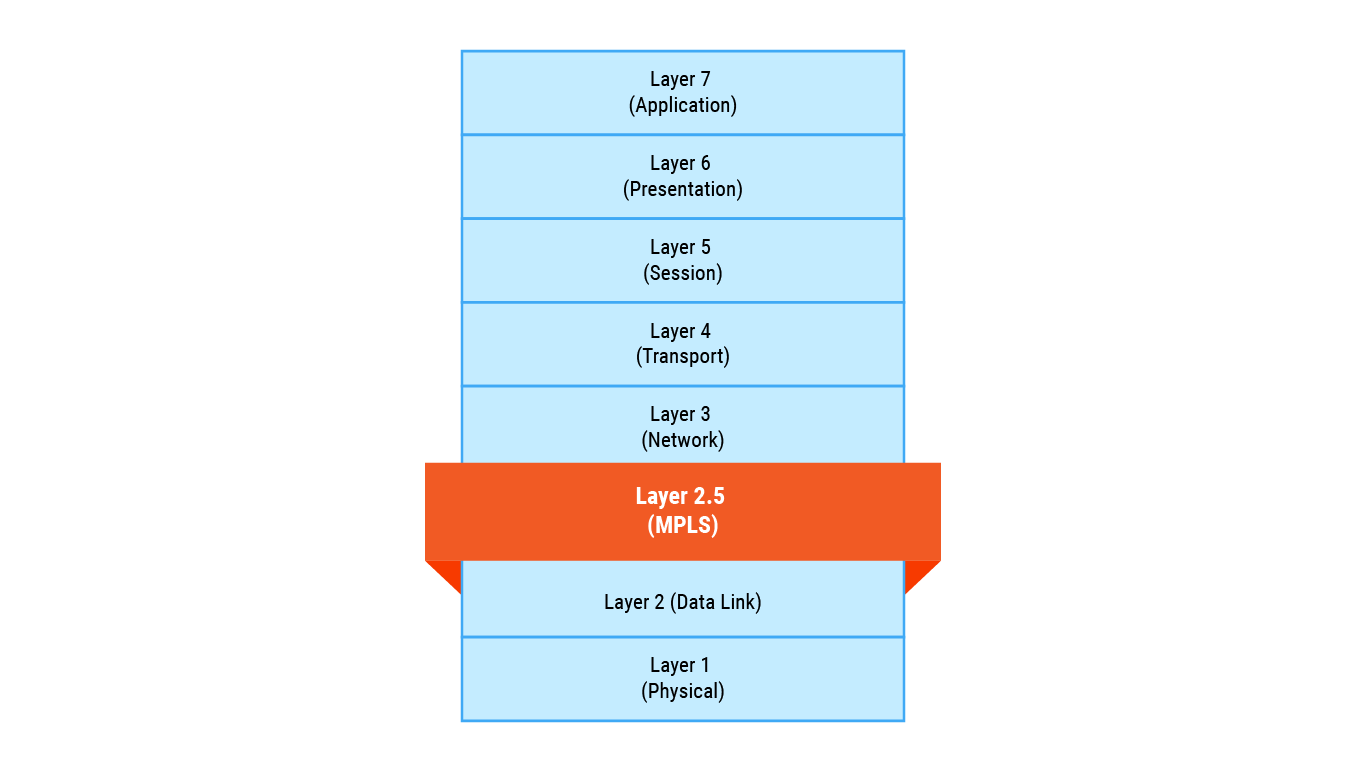
Sitting between Layer 2 & Layer 3, MPLS is considered a Layer 2.5 networking protocol.
While switching is a Layer 2 operation, routing is a Layer 3 operation. MPLS enables Internet routers to function like local network switches and can create end-to-end paths that behave like circuit-switched connections, but deliver Layer 3 IP packets. MPLS uses labels at Layer 2.5 to reduce the resource-intensive lookups at Layer 3 and helps in creating forwarding tables for any underlying protocol.
How does MPLS work?
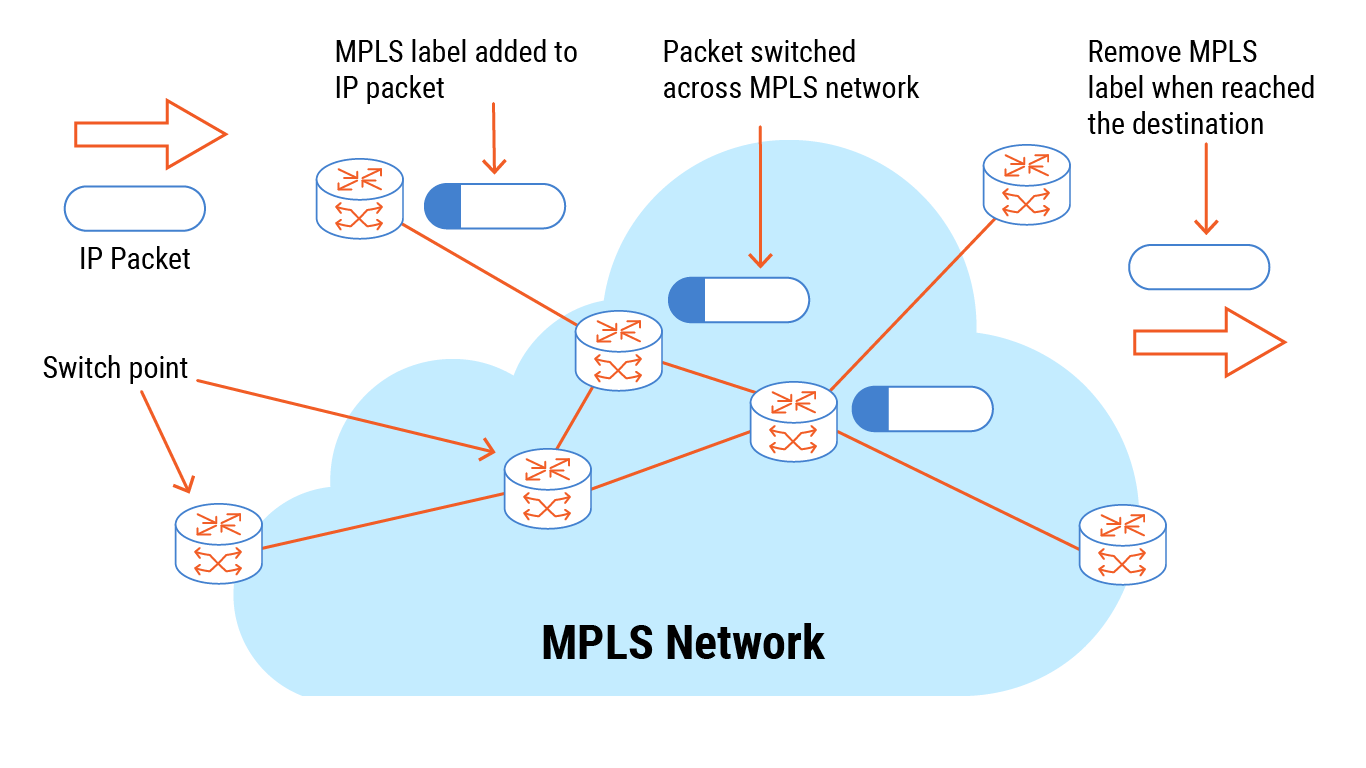
MPLS works by adding a label to the data packet & route the packet from one node to the next based on the information written on the label.
Each packet in an MPLS network is assigned a class designation known as a forwarding equivalence class (FEC). Label-switched paths (LSPs) refer to the potential network routes that packets can take. The path (LSP) that a packet is assigned to is decided by its class (FEC). All packets with the same FEC always take the same LSP.
One or more labels are attached to each packet, and each label is in its own MPLS header, which is placed on top of all other headers. Each packet’s labels provide a list of FECs. Routers can disregard the IP header and other headers of the packet and instead look at the packet’s label to send it to the appropriate LSP.
An MPLS router located at the network edge adds an MPLS label whenever an end-user sends traffic into the MPLS network.
The MPLS label is consisted of four sections:
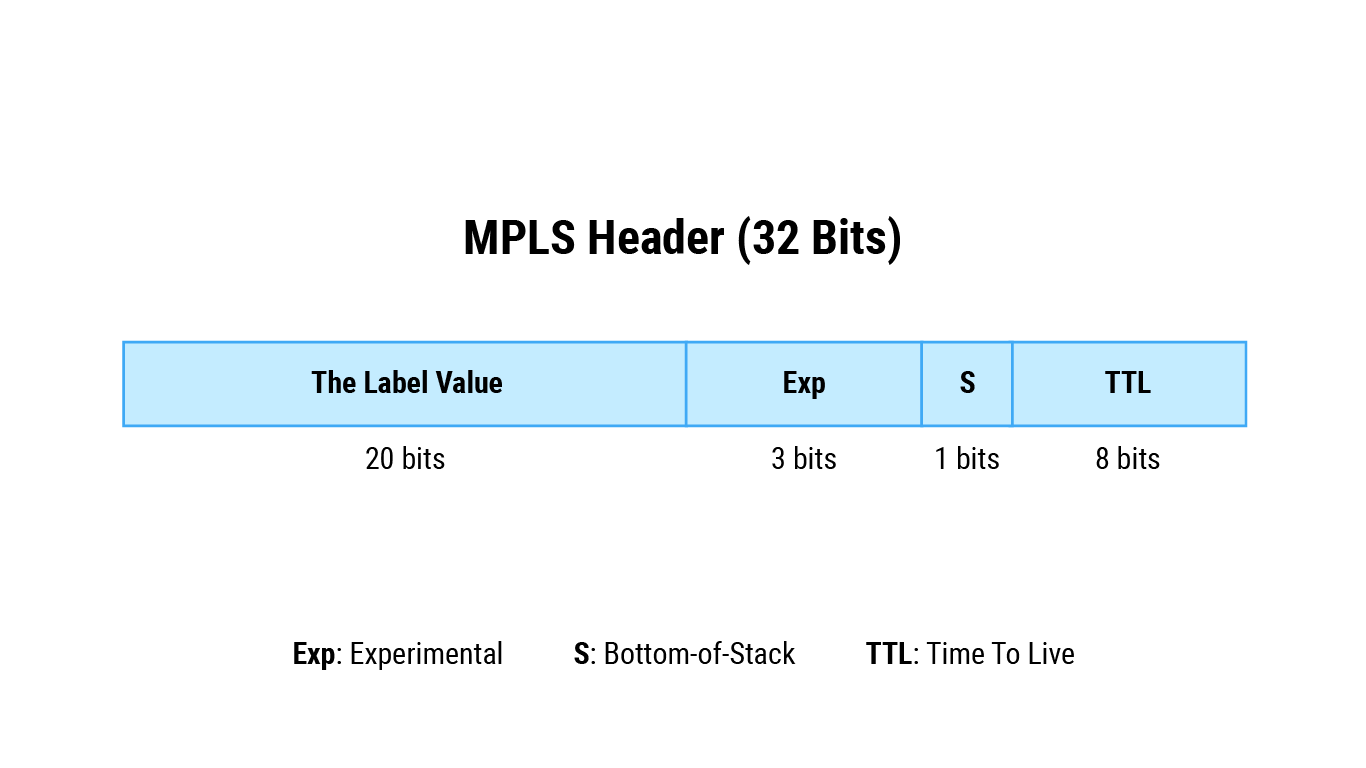
A MPLS header contains 32 Bits (4 Bytes) and is made of 4 sub sections: The Label Value, Experimental, Bottom-of-Stack, and Time-To-Live.
First 20 bits – The Label Value:
The label contains all the information MPLS routers need to decide where to forward the packet.
Next 3 bits – Experimental:
Experimental bits are used to determine the labeled packet’s priority and explicit congestion notification (ECN) under Quality of Service (QoS).
Next 1 bit – Bottom-of-Stack:
Bottom-of-Stack notifies that the packet has reached the end of the MPLS network route, and there are no more labels to worry about. Typically, this indcates that the router is an egress router.
Last 8 bits – Time To Live (TTL):
This indicates the maximum number of hops a packet can make before being discarded.
MPLS vs. SD-WAN: The pros and cons of MPLS
The advantages and disadvantages of MPLS
The biggest benefit that MPLS offers is its ability to support and manage multiple protocols and transmission media. It can create LSPs for various protocols ranging from IP, Ethernet, Asynchronous Transfer Mode (ATM), to Frame Relay.
The pros of MPLS:
-
High reliability for data communications and real-time applications requiring low latency
-
Ability to allocate a specific percentage of bandwidth for various data types
-
Capability to oversee various voice and data applications on the same MPLS network
-
Ability to provision more bandwidth to scale up the network
-
Traffic Engineering to ease network congestion
-
Capability for organizations with multiple sites to create IP VPNs without setting up a complex tunnel mesh
-
Ability to manage various data transmission types with different priorities and service levels
-
Quality of Service (QoS) and Class of Service (CoS) policies on individual traffic to ensure consistent network performance
-
MPLS network management tools that make global changes easier by applying settings across an entire WAN all at once
-
Excellent customer service provided by MPLS NOC teams who have a thorough understanding of their clients.
The cons of MPLS:
-
Compared to other connectivity options, MPLS can be expensive because it is built to guarantee high bandwidth, excellent performance, and competitive SLAs.
-
Deploying and maintaining MPLS private connections requires significant resources.
-
MPLS can only operate in dedicated infrastructures where it is deployed.
-
MPLS is not compatible with cloud systems because it is built for point-to-point connectivity, which can limit flexibility and scalability.
MPLS vs. SD-WAN
Over the past few years, the industry has noticed an increase in interest in SD-WAN. Thus, one of the most common questions on the mind of most IT leaders when considering their WAN architecture is: “SD-WAN vs MPLS – Which Is the right choice for my business?”
SD-WAN (or SDWAN) applies the concept of Software Defined Networking to distribute network traffic over a WAN. SD-WAN can build a virtual network, which is abstracted from its hardware, to connect and centralize several sites.
MPLS would be the ideal choice if your business value:
-
Granular packet control: The location of packets can be controlled more precisely with MPLS. The route that MPLS network traffic takes is fixed and predictable, whereas the route that SD-WAN network traffic takes may vary, and some packets may get lost in the process.
-
Quality of Service (QoS): A common feature of MPLS services is QoS guaranteed and SLA-backed dedicated route. MPLS can provide better QoS for critical applications than SD-WAN, which employs the best effort and is susceptible to packet loss.
-
Real-time applications: For real-time applications that require low latency and high reliability, MPLS is preferable to SD-WAN.
-
Predictability: MPLS provides more predictable routing than SD-WAN because it requires dedicated private line connections.
-
Zero latency: MPLS is a “switching” technology that have near zero latency on each router passing. While SD-WAN rather routed on all routers in transit, which add substantial jitter, latency, and potential asymmetry.
SD-WAN is an attractive alternative for organizations that concern about:
-
Cost and Scalability: Cost and Scalability: SD-WAN is independent from any single carrier or form of connectivity, making your WAN cheaper and easier to scale.
-
No bandwidth limit: SD-WANs don’t have built-in bandwidth restrictions.
-
Flexible routing: Routing with SD-WAN is more flexible.
-
SaaS or cloud applications: Cloud integration is simpler with SD-WANs. Building a direct path is necessary for MPLS connections to the cloud.
Consider a EoMPLS Pseudowire Approach
As businesses grow, it becomes increasingly crucial to employ a dependable and secure network solution. With our global multiprotocol label switching solutions, regional and international offices can greatly benefit from real-time communication, online collaboration, and cloud applications.
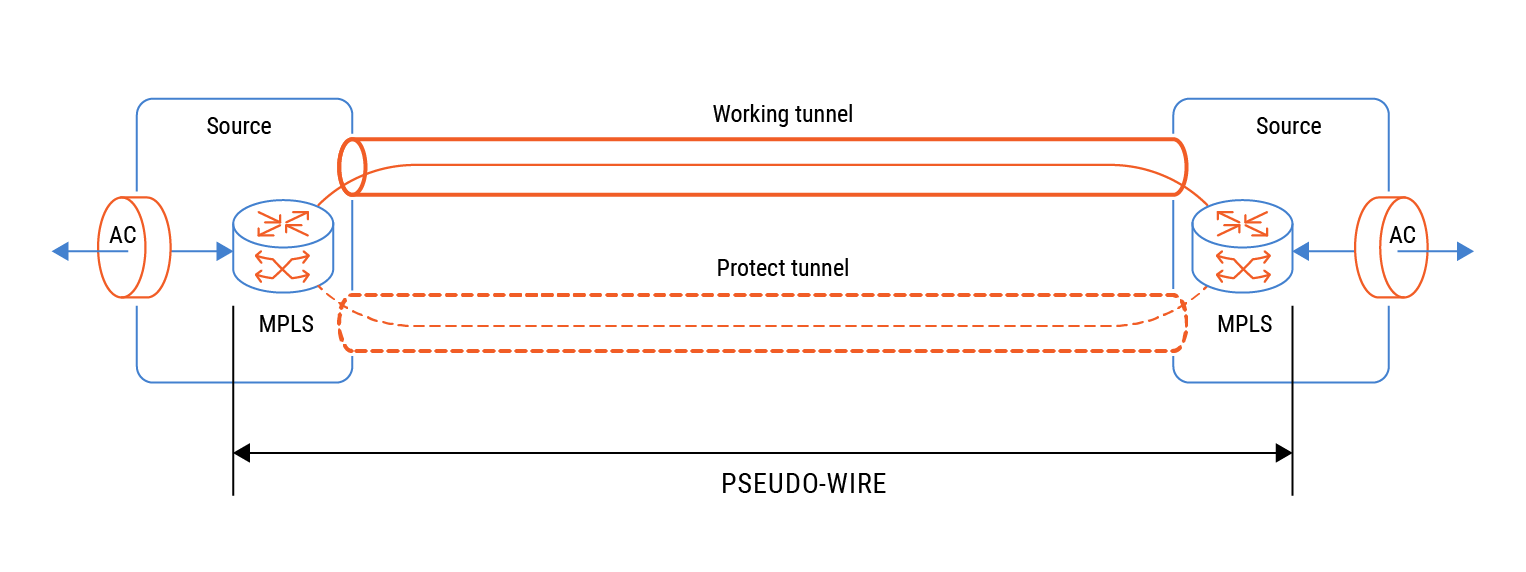
EoMPLS pseudowire creates an end-to-end tunnel to transport Ethernet encapsulated traffic across an MPLS network.
Any Transport over MPLS (AToM) is an application of Layer 2 MPLS-driven solutions. MPLS has the capability to transport not only Ethernet frames but also Frame Relay and ATM, making it a versatile technology. A pseudowire can be created using Ethernet over MPLS (EoMPLS) to simulate a single Ethernet cable. This allows the service provider network to function like an Ethernet cable from the customer’s point of view. The MAC addresses discovered through this connection are those of the customer devices on the opposite side of the EoMPLS pseudowire. In essence, the MPLS network is transparent to the customer.
With more than 235 points of presence (POPs) in our global MPLS network, IPTP Networks is well positioned to be your network partner for scalable wide area network access as your company expands internationally.
Learn more about how EoMPLS Pseudowire offers a scalable, secure, reliable and transparent connectivity for your regional and global offices.
